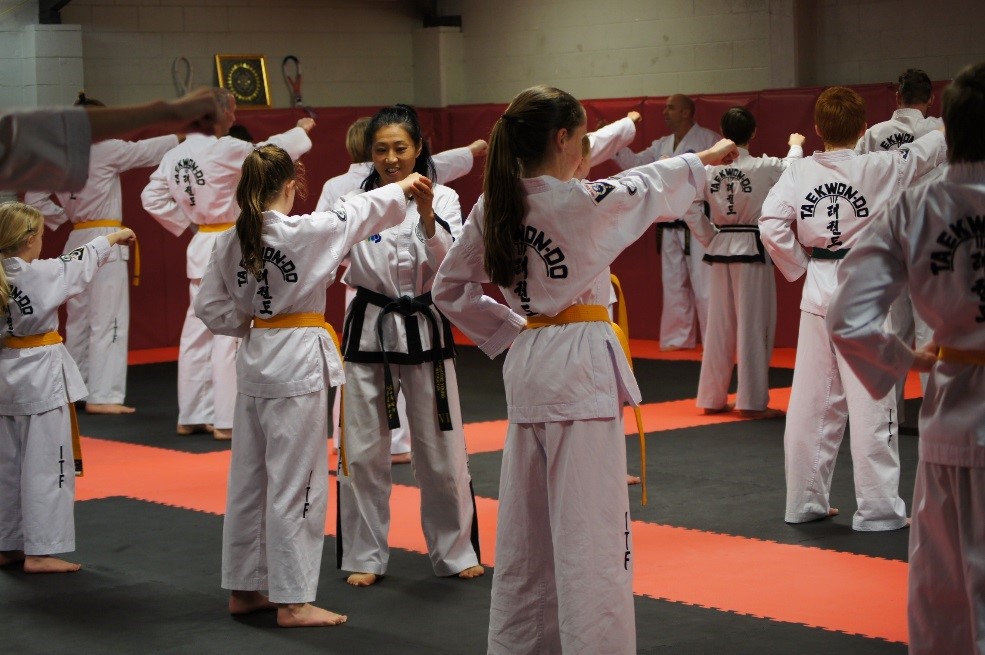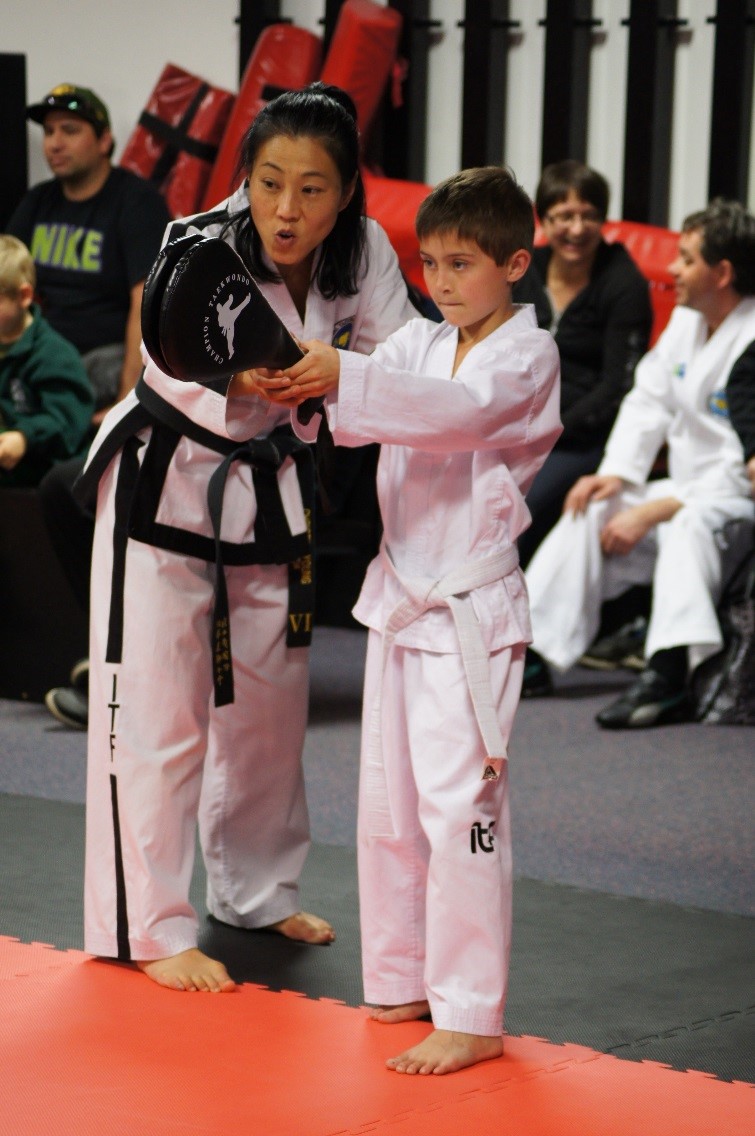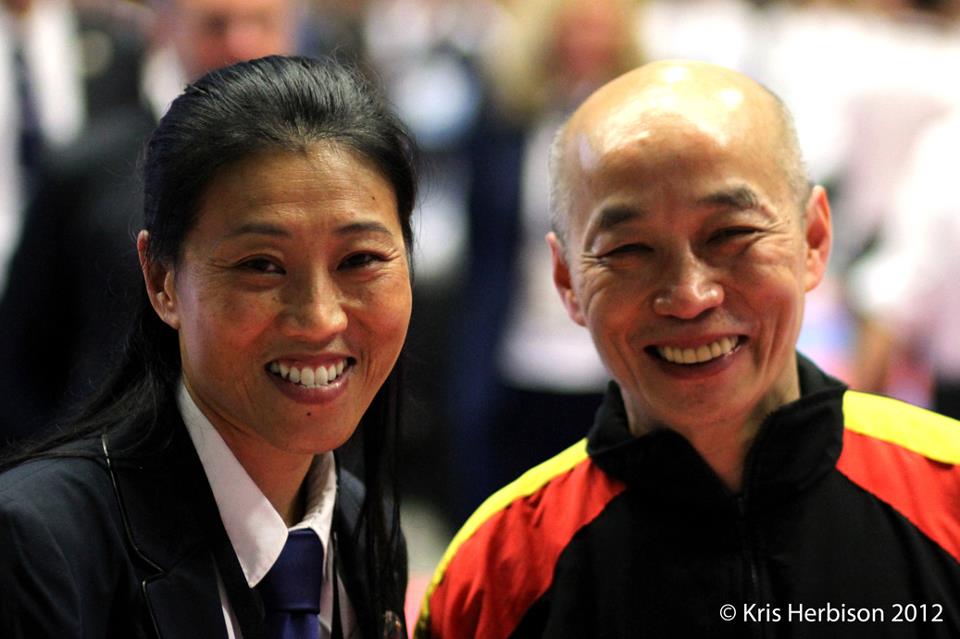Mrs Christine Young-Jasberg, 6th Dan, Hwa Rang Academy, Co-Founder The MAA
From CA to MA – chartered accountant to martial artist…. From Suited and Booted to Dobok and barefoot

How cool is it to put martial arts instructor on your departure card for customs? That’s what I do now. With you on that Mr Brendan Doogan.
It’s just been over three years since I took the plunge to make teaching Taekwon-Do my full-time profession. That’s how I have always approached instructing, as a professional service, whilst doing something I love.
I had trained to be a chartered accountant which took me around the world, and I loved my job in this sector. I had a successful, fun and fulfilling career in Oxford and London. After ten years in England, I decided to move back to New Zealand and settle in Tauranga for a better work / life balance.
In Tauranga, I found time to take up other sports and pursue my love of the martial arts. My partner and I started the Hwa Rang Taekwon-Do clubs. I enjoyed teaching, and I liked teaching big classes. These gave me lots of energy and I loved seeing lots of students. My biggest classes were at the local intermediate school where there were over 50 students signed up for an after-school session. These were full on. Among the students in the first class I ever took in New Zealand was a Ms Kara Timmer, who has since gone on to become junior and senior world champion at multi disciplines.
After 6 years teaching from local school halls, students and the Hwa Rang club were doing well, students were having good success at reaching the ranks of black belt and competing internationally. However, I always had big dreams to have a permanent facility where it could be called a centre of excellence. To have some where we could share more, and teach more than just the grading syllabus of ITKD Taekwon-do. I wanted to explore fitness and enable students to really reach their full potential in TKD whether it be teaching, competing or just trick kicking.
Inspired by Mr Jon Matsuoka’s mancave, in 2013 I teamed up with my now business partner, Scott Coburn, who is a student, a dad of two of my students and all round mad martial arts visionary to start the Martial Arts Academy. We invested to make our centre a first-class facility, and we did that. Over 1,000 people attended our official opening day on October 14th 2013. For the first year I kept my security blanket of a day job by staying on as a consultant at the chartered accountancy that I had been working for, though on a very part time basis.
I was instructing about 18 hours a week, which is quite a heavy instructing workload, teaching all level of classes. After 3.5 years of tweaking our recipe for running a full time centre, which is a balance between great instructing, good administration, and ongoing marketing, both my business partner and I are ‘full time’ at the Academy.
We treat instructing like a profession. We give a professional service in a professional environment. We are passionate about what we teach, how we teach it and we care about our students. It is very much like being a doctor, a lawyer, a chartered accountant. We have ongoing professional development amongst our instructor team, and have ongoing job training to ensure our teaching standards are the highest possible. In any case students will vote with their feet.
We are now teaching and reaching more people in the Bay than if I had remained a hobbyist operating in a community hall. Our students get to enjoy a purposefully kitted out training facility and access to more instructors. It’s not just me. We very much operate as a team at TMAA. Scott and I have always wanted to make martial arts instructing as much of a valid career choice as personal trainer, life coach, doctor, counsellor, or fire fighter. After all, that’s what instructor’s already do.
When I was in London I trained amongst many ‘professional Taekwon-Do’ instructors, and the magic number of students to teach to turn ‘professional’ and give up your day job was 200. This is a good rule of thumb.
I believe, with the strength of our ITKD organisation giving the foundational support and having a high level of trust and brand goodwill from the public all a new instructor needs is the passion to teach. Being a martial arts instructor is very much a career option. A new dawn has arisen in New Zealand.

It is not rocket science, so here are some other common FAQ s around becoming a full time M A:
1. How much could I expect to earn with 200 students?
When compared to earning a salary as a chartered accountant and now martial arts instructor, I am roughly earning the same hourly rate. So, though my salary is about the same, other perks are I get to train whenever I want and going to seminars and overseas events like the recent Arnold Classic in Melbourne becomes a business expense. I am also following my passion of continuing learning and finding time to practice other martial arts and count that as work time.
2. How much time do I need to spend on teaching?
You will need to treat it like your full time job initially, so expect to do a 40 hour week. How much time you allocate between teaching, administration and marketing is up to you and what other resources you have at your disposal. I initially spent about one third of my time on each of those main functions.
3. Do I have to increase my club fees? And If I do would some students leave?
When we reach the rank of 4th dan, Sabum-nim, we have spent at least 10 years learning and upskilling in the art of Taekwon-Do. It took me 3 years at university and 3 years work experience to qualify as a chartered accountant. I was then able to charge big bucks for my skills and services. We need to put a value on our skills and experience as martial arts instructors commensurate with our investment and value. The best guide to a new instructor is to charge what you feel in your heart you are worth. Then you are aligning your values with what you are giving to your students. You will not feel guilty about charging for training.
If you feel that means increasing your fees, then if some students leave purely on the financial reason, they were not aligned with your values. The exit survey from our ITKD leaving-surveys show that a very small minority of students leave a club for financial reasons.
4. Should I rent a permanent facility?
This is a good question and depends on your current student numbers and whether you have some capital to invest in a permanent facility. Having a permanent venue will ultimately lead to faster success and higher student numbers, as you are able to offer more class times and thus teach more students. Thus the answer is really not should I but when is the right time to commit to a facility. Some people wish they had bought property sooner. There is no time like the present to do what you think you should have done years ago.
I am very happy to share my experience of starting the Martial Arts Academy from a business owner and instructor perspective. Send me a private message me.
